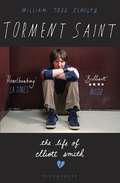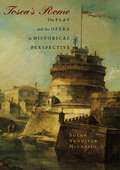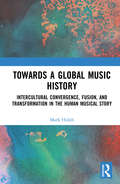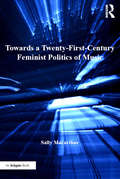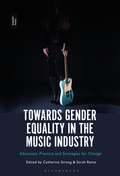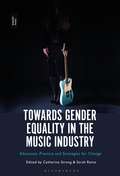- Table View
- List View
Torment Saint: The Life of Elliott Smith
by William Todd SchultzElliott Smith was one of the most gifted songwriters of the nineties, adored by worshipful fans for his subtly melancholic words and melodies. The sadness had its sources in the life. There was trauma from an early age, years of drug abuse and a chronic sense of disconnection that sometimes seemed almost self-engineered. Smith died violently in Los Angeles in 2003, under what some believe to be questionable circumstances, of a single fatal stab wound to the chest. By this time fame had found him, and record buyers who shared the listening experience felt he spoke directly to them from beyond: lonely, lovelorn, frustrated, fighting until he could fight no more. And yet, although his achingly intimate lyrics carried the weight of truth, Smith remained unknowable. In Torment Saint, William Todd Schultz gives us the first proper biography of the rock star, a decade after his death, imbued with affection, authority, sensitivity and long-awaited clarity.Torment Saint draws on Schultz's careful, deeply knowledgeable readings and insights, as well as on more than 150 hours of interviews with close friends, lovers, bandmates, peers, managers, label owners, and recording engineers and producers. This book unravels the remaining mysteries of Smith's life and his shocking, too-early end. It will be an indispensable examination of his life and legacy, both for Smith's legions of fans as well as readers still discovering his songbook.
Torment Saint: The Life of Elliott Smith
by William Todd SchultzElliott Smith was one of the most gifted songwriters of the '90s, adored by fans for his subtly melancholic words and melodies.The sadness had its sources in the life.There was trauma from an early age, years of drug abuse, and a chronic sense of disconnection that sometimes seemed self-engineered.Smith died violently in LA in 2003, under what some believe to be questionable circumstances, of stab wounds to the chest.By this time fame had found him, and record-buyers who shared the listening experience felt he spoke directly to them from beyond:astute, damaged, lovelorn, fighting, until he could fight no more. And yet, although his intimate lyrics carried the weight of truth, Smith remained unknowable. In Torment Saint, William Todd Schultz gives us the first proper biography of the rock star, a decade after his death, imbued with affection, authority, sensitivity, and long-awaited clarity.Torment Saint draws on Schultz's careful, deeply knowledgeable readings and insights, as well as on more than 150 hours of interviews with close friends from Texas to Los Angeles, lovers, bandmates, music peers, managers, label owners, and recording engineers and producers. This book unravels the remaining mysteries of Smith's life and his shocking, too early end.It will be, for Smith's legions of fans and readers still discovering his songbook, an indispensable examination of his life and legacy.
Tosca's Rome: The Play and the Opera in Historical Perspective
by Susan Vandiver NicassioA timeless tale of love, lust, and politics, Tosca is one of the most popular operas ever written. In Tosca's Rome, Susan Vandiver Nicassio explores the surprising historical realities that lie behind Giacomo Puccini's opera and the play by Victorien Sardou on which it is based. By far the most "historical" opera in the active repertoire, Tosca is set in a very specific time and place: Rome, from June 17 to 18, 1800. But as Nicassio demonstrates, history in Tosca is distorted by nationalism and by the vehement anticlerical perceptions of papal Rome shared by Sardou, Puccini, and the librettists. To provide the historical background necessary for understanding Tosca, Nicassio takes a detailed look at Rome in 1800 as each of Tosca's main characters would have seen it—the painter Cavaradossi, the singer Tosca, and the policeman Scarpia. Finally, she provides a scene-by-scene musical and dramatic analysis of the opera. "[Nicassio] must be the only living historian who can boast that she once sang the role of Tosca. Her deep knowledge of Puccini's score is only to be expected, but her understanding of daily and political life in Rome at the close of the 18th century is an unanticipated pleasure. She has steeped herself in the period and its prevailing culture-literary, artistic, and musical-and has come up with an unusual, and unusually entertaining, history."—Paul Bailey, Daily Telegraph "In Tosca's Rome, Susan Vandiver Nicassio . . . orchestrates a wealth of detail without losing view of the opera and its pleasures. . . . Nicassio aims for opera fans and for historians: she may well enthrall both."—Publishers Weekly "This is the book that ranks highest in my estimation as the most in-depth, and yet highly entertaining, journey into the story of the making of Tosca."—Catherine Malfitano "Nicassio's prose . . . is lively and approachable. There is plenty here to intrigue everyone-seasoned opera lovers, musical novices, history buffs, and Italophiles."—Library Journal
The Total Work of Art: Foundations, Articulations, Inspirations (Spektrum: Publications of the German Studies Association #12)
by David Imhoof, Margaret Eleanor Menninger, and Anthony J. SteinhoffFor two centuries, Gesamtkunstwerk—the ideal of the “total work of art”—has exerted a powerful influence over artistic discourse and practice, spurring new forms of collaboration and provoking debates over the political instrumentalization of art. Despite its popular conflation with the work of Richard Wagner, Gesamtkunstwerk’s lineage and legacies extend well beyond German Romanticism, as this wide-ranging collection demonstrates. In eleven compact chapters, scholars from a variety of disciplines trace the idea’s evolution in German-speaking Europe, from its foundations in the early nineteenth century to its manifold articulations and reimaginings in the twentieth century and beyond, providing an uncommonly broad perspective on a distinctly modern cultural form.
Totally Wired: Postpunk Interviews and Overviews
by Simon ReynoldsFrom the author of the bestselling postpunk history Rip It Up and Start Again comes Totally Wired, a companion book of conversations with the brilliant minds who made the late seventies and early eighties such a creative era for radical music and alternative culture. Totally Wired features thirty-two interviews with postpunk's most innovative musicians and colourful personalities - Ari Up, Jah Wobble, David Byrne, Green Gartside, Lydia Lunch, Edwyn Collins - as well as other movers and shakers of the period: label bosses and managers like Anthony H. Wilson and Bill Drummond, record producers such as Trevor Horn and Martin Rushent, and influential DJs and journalists like John Peel and Paul Morley. Crackling with argument and anecdote, the conversations in Totally Wired bring a rich human dimension to the postpunk story chronicled in the critically acclaimed Rip It Up. We get to follow these exceptional (and often eccentric) characters from their earliest days through the glory and sometimes disaster of their musical adventures to what they went on to do after postpunk. We gain a vivid sense of individuals struggling against the odds to make their world as interesting as possible, in the process leaving a legacy of artistic ambition and provocation that reverberates to this day. Along with the interviews, Totally Wired also includes a bonus 'overviews' section: further reflections by Simon Reynolds on postpunk's key icons and crucial scenes, including John Lydon and Public Image Ltd, Ian Curtis and Joy Division, art school conceptualists and proto-postpunkers Brian Eno and Malcolm McLaren, and the lineage of glam grotesquerie running from Siouxsie & The Banshees to the New Romantics to Leigh Bowery. Buzzing with ideas and insights, Totally Wired is an absolute mind rush.
Touching From a Distance: Ian Curtis And Joy Division
by Deborah CurtisThe only in-depth biographical account of the legendary lead singer of Joy Division, written by his widow. Includes a foreword by Jon Savage and an introduction by Joy Division drummer, Steven Morris. Revered by his peers and idolized by his fans, Ian Curtis left behind a legacy rich in artistic genius. Mesmerizing on stage but introverted and prone to desperate mood swings in his private life, Curtis died by his own hand on 18 May 1980.Touching from a Distance documents how, with a wife, child and impending international fame, Curtis was seduced by the glory of an early grave. Regarded as the essential book on the essential icon of the post-punk era, Touching from a Distance includes a full set of Curtis's lyrics and a discography and gig list.
Touraj Kiaras and Persian Classical Music: An Analytical Perspective
by Owen WrightIn this book Owen Wright analyses a single recording of classical Persian music made by Touraj Kiaras, a distinguished singer, accompanied by four noted instrumentalists. The format of the recording is typical of a public concert performance, and thus includes instrumental compositions as well as a central exploration of vocal repertoire and technique. The analysis identifies salient structural features, whether of the individual components or of the whole, in a way accessible to the western reader, but it also takes account of the analytical metalanguage used in Persian scholarship, and includes consideration of the relationship between music and poetry. It is important to note that it is also guided by the perceptions of the performer, whose input and responses to questions have significantly influenced the enterprise. To avoid the dryly impersonal, the analysis is also framed by an introduction which combines a biographical sketch of Touraj Kiaras with a survey of the twentieth-century evolution of Persian classical music and of the position of the vocal repertoire within it, and by an epilogue which examines further the ideological basis of prevalent attitudes to music, and seeks to explore the validity of the analytical enterprise within this context.
Touraj Kiaras and Persian Classical Music: An Analytical Perspective
by Owen WrightIn this book Owen Wright analyses a single recording of classical Persian music made by Touraj Kiaras, a distinguished singer, accompanied by four noted instrumentalists. The format of the recording is typical of a public concert performance, and thus includes instrumental compositions as well as a central exploration of vocal repertoire and technique. The analysis identifies salient structural features, whether of the individual components or of the whole, in a way accessible to the western reader, but it also takes account of the analytical metalanguage used in Persian scholarship, and includes consideration of the relationship between music and poetry. It is important to note that it is also guided by the perceptions of the performer, whose input and responses to questions have significantly influenced the enterprise. To avoid the dryly impersonal, the analysis is also framed by an introduction which combines a biographical sketch of Touraj Kiaras with a survey of the twentieth-century evolution of Persian classical music and of the position of the vocal repertoire within it, and by an epilogue which examines further the ideological basis of prevalent attitudes to music, and seeks to explore the validity of the analytical enterprise within this context.
Towards a Global Music History: Intercultural Convergence, Fusion, and Transformation in the Human Musical Story
by Mark HijlehHow do we explain the globalized musical world in which we find ourselves in the early 21st century and how did we arrive here? This extraordinary book outlines an understanding of the human musical story as an intercultural—and ultimately a transcultural—one, with travel and trade as the primary conditions and catalysts for the ongoing development of musical styles. Starting with the cultural and civilizational precedents that gave rise to the first global trading and travel network in both directions across the Afro-Eurasian Old World Web in the form of the Silk Road, the book proceeds to the rise of al-Andalus and its influence on Europe through the Iberian peninsula before considering the fusion of European, African and indigenous musics that emerged in the Americas between c1500-1920 as part of Atlantic culture and the New World Web, as well as the concurrent acceleration of globalism in music through European empires and exoticism. The book concludes by examining the musical implications of our current Age of Instantaneous Exchange that technology permits, and by revisiting the question of interculturality and transculurality in music.
Towards a Global Music History: Intercultural Convergence, Fusion, and Transformation in the Human Musical Story
by Mark HijlehHow do we explain the globalized musical world in which we find ourselves in the early 21st century and how did we arrive here? This extraordinary book outlines an understanding of the human musical story as an intercultural—and ultimately a transcultural—one, with travel and trade as the primary conditions and catalysts for the ongoing development of musical styles. Starting with the cultural and civilizational precedents that gave rise to the first global trading and travel network in both directions across the Afro-Eurasian Old World Web in the form of the Silk Road, the book proceeds to the rise of al-Andalus and its influence on Europe through the Iberian peninsula before considering the fusion of European, African and indigenous musics that emerged in the Americas between c1500-1920 as part of Atlantic culture and the New World Web, as well as the concurrent acceleration of globalism in music through European empires and exoticism. The book concludes by examining the musical implications of our current Age of Instantaneous Exchange that technology permits, and by revisiting the question of interculturality and transculurality in music.
Towards a Global Music Theory: Practical Concepts and Methods for the Analysis of Music Across Human Cultures
by Mark HijlehSince the beginning of the twentieth century, the cross-pollenization of world musical materials and practices has accelerated precipitously, due in large part to advances in higher-speed communications and travel. We live now in a world of global musical practice that will only continue to blossom and develop through the twenty-first century and beyond. Yet music theory as an academic discipline is only just beginning to respond to such a milieu. Conferences, workshops and curricula are for the first time beginning to develop around the theme of 'world music theory', as students, teachers and researchers recognize the need for analytical concepts and methods applicable to a wider range of human musics, not least the hybrid musics that influence (and increasingly define) more and more of the world's musical practices. Towards a Global Music Theory proposes a number of such concepts and methods stemming from durational and acoustic relationships between 'twos' and 'threes' as manifested in various interrelated aspects of music, including rhythm, melody, harmony, process, texture, timbre and tuning, and offers suggestions for how such concepts and methods might be applied effectively to the understanding of music in a variety of contexts. While some of the bases for this foray into possible methods for a twenty-first century music theory lie along well established acoustical and psycho-acoustical lines, Dr Mark Hijleh presents a broad attempt to apply them conceptually and comprehensively to a variety of musics in a relevant way that can be readily apprehended and applied by students, scholars and teachers.
Towards a Global Music Theory: Practical Concepts and Methods for the Analysis of Music Across Human Cultures
by Mark HijlehSince the beginning of the twentieth century, the cross-pollenization of world musical materials and practices has accelerated precipitously, due in large part to advances in higher-speed communications and travel. We live now in a world of global musical practice that will only continue to blossom and develop through the twenty-first century and beyond. Yet music theory as an academic discipline is only just beginning to respond to such a milieu. Conferences, workshops and curricula are for the first time beginning to develop around the theme of 'world music theory', as students, teachers and researchers recognize the need for analytical concepts and methods applicable to a wider range of human musics, not least the hybrid musics that influence (and increasingly define) more and more of the world's musical practices. Towards a Global Music Theory proposes a number of such concepts and methods stemming from durational and acoustic relationships between 'twos' and 'threes' as manifested in various interrelated aspects of music, including rhythm, melody, harmony, process, texture, timbre and tuning, and offers suggestions for how such concepts and methods might be applied effectively to the understanding of music in a variety of contexts. While some of the bases for this foray into possible methods for a twenty-first century music theory lie along well established acoustical and psycho-acoustical lines, Dr Mark Hijleh presents a broad attempt to apply them conceptually and comprehensively to a variety of musics in a relevant way that can be readily apprehended and applied by students, scholars and teachers.
Towards a Harmonic Grammar of Grieg's Late Piano Music: Nature and Nationalism (Royal Musical Association Monographs)
by Benedict TaylorThe music of Edvard Grieg is justly celebrated for its harmonic richness, a feature especially apparent in the piano works written in the last decades of his life. Grieg was enchanted by what he styled the ’dreamworld’ of harmony, a magical realm whose principles the composer felt remained a mystery even to himself, and he was not alone, in that the complex nature of late-Romantic harmony around 1900 has proved a keen source of debate up to the present day. Grieg’s music forms a particularly profitable repertoire for focusing current debates about the nature of tonality and tonal harmony. Departing from earlier approaches, this study is not simply an inventory of Griegian harmonic traits but seeks rather to ascertain the deeper principles at work governing their meaningful conjunction, how elements of Grieg’s harmonic grammar are utilised in creating an extended tonal syntax. Building both on historical theories and more recent developments, Benedict Taylor develops new models for understanding the complexity of late-Romantic tonal practice as epitomised in Grieg’s music. Such an investigation casts further valuable light on the twin issues of nature and nationalism long connected with the composer: the question of tonality as something natural or culturally constructed and larger historiographical claims concerning Grieg’s apparent position on the periphery of the Austro-German tradition.
Towards a Harmonic Grammar of Grieg's Late Piano Music: Nature and Nationalism (Royal Musical Association Monographs)
by Benedict TaylorThe music of Edvard Grieg is justly celebrated for its harmonic richness, a feature especially apparent in the piano works written in the last decades of his life. Grieg was enchanted by what he styled the ’dreamworld’ of harmony, a magical realm whose principles the composer felt remained a mystery even to himself, and he was not alone, in that the complex nature of late-Romantic harmony around 1900 has proved a keen source of debate up to the present day. Grieg’s music forms a particularly profitable repertoire for focusing current debates about the nature of tonality and tonal harmony. Departing from earlier approaches, this study is not simply an inventory of Griegian harmonic traits but seeks rather to ascertain the deeper principles at work governing their meaningful conjunction, how elements of Grieg’s harmonic grammar are utilised in creating an extended tonal syntax. Building both on historical theories and more recent developments, Benedict Taylor develops new models for understanding the complexity of late-Romantic tonal practice as epitomised in Grieg’s music. Such an investigation casts further valuable light on the twin issues of nature and nationalism long connected with the composer: the question of tonality as something natural or culturally constructed and larger historiographical claims concerning Grieg’s apparent position on the periphery of the Austro-German tradition.
Towards a Twenty-First-Century Feminist Politics of Music
by Sally MacarthurTowards a Twenty-First-Century Feminist Politics of Music opens up a new way of thinking about the absence of women's music. It does not aim to find 'a solution' in a liberal feminist sense, but to discover new potentialities, new possibilities for thought and action. Sally Macarthur encourages us, with the assistance of Deleuze, and feminist-Deleuzian work, to begin the important work of imagining what else might be possible, not in order to provide answers but to open up the as yet unknown. The power of thought - or what Deleuze calls the 'virtual' - opens up new possibilities. Macarthur suggests that the future for women's 'new' music is not tied to the predictable and known but to futures beyond the already-known. Previous research concludes that women's music is virtually absent from the concert hall, and yet fails to find a way of changing this situation. Macarthur finds that the flaw in the recommendations flowing from past research is that it envisages the future from the standpoint of the present, and it relies on a set of pre-determined goals. It thus replicates the present reality, so reinforcing rather than changing the status quo. Macarthur challenges this thinking, and argues that this repetitive way of thinking is stuck in the present, unable to move forward. Macarthur situates her argument in the context of current dominant neoliberal thought and practice. She argues that women have generally not thrived in the neoliberal model of the composer, which envisages the composer as an individual, autonomous creator and entrepreneur. Successful female composers must work with this dominant, modernist aesthetic and exploit the image of the neo-romantic, entrepreneurial creator. This book sets out in contrast to develop a new conception of subjectivity that sows the seeds of a twenty-first-century feminist politics of music.
Towards a Twenty-First-Century Feminist Politics of Music
by Sally MacarthurTowards a Twenty-First-Century Feminist Politics of Music opens up a new way of thinking about the absence of women's music. It does not aim to find 'a solution' in a liberal feminist sense, but to discover new potentialities, new possibilities for thought and action. Sally Macarthur encourages us, with the assistance of Deleuze, and feminist-Deleuzian work, to begin the important work of imagining what else might be possible, not in order to provide answers but to open up the as yet unknown. The power of thought - or what Deleuze calls the 'virtual' - opens up new possibilities. Macarthur suggests that the future for women's 'new' music is not tied to the predictable and known but to futures beyond the already-known. Previous research concludes that women's music is virtually absent from the concert hall, and yet fails to find a way of changing this situation. Macarthur finds that the flaw in the recommendations flowing from past research is that it envisages the future from the standpoint of the present, and it relies on a set of pre-determined goals. It thus replicates the present reality, so reinforcing rather than changing the status quo. Macarthur challenges this thinking, and argues that this repetitive way of thinking is stuck in the present, unable to move forward. Macarthur situates her argument in the context of current dominant neoliberal thought and practice. She argues that women have generally not thrived in the neoliberal model of the composer, which envisages the composer as an individual, autonomous creator and entrepreneur. Successful female composers must work with this dominant, modernist aesthetic and exploit the image of the neo-romantic, entrepreneurial creator. This book sets out in contrast to develop a new conception of subjectivity that sows the seeds of a twenty-first-century feminist politics of music.
Towards an Ontology of Teaching: Thing-centred Pedagogy, Affirmation and Love for the World (Contemporary Philosophies and Theories in Education #11)
by Joris Vlieghe Piotr ZamojskiThis book opens an original and timely perspective on why it is we teach and want to pass on our world to the new generation. Teaching is presented in this book as a way of being, rather than as a matter of expertise, which is driven by love for a subject matter. With the help of philosophical thinkers such as Arendt, Badiou and Agamben, the authors articulate a fully positive account of education that goes beyond the critical approach, which has become prevailing in much contemporary educational theory, and which testifies to a hate of the world and to a confusion of what politics and education are about. Therefore, the authors develop the idea of a thing-centred pedagogy, as opposed to both teacher-centred and student-centred approaches. The authors furthermore illustrate their purely educational account of teaching by looking at the writing and the television performance of Leonard Bernstein who embodies what teaching out of love and care for a subject is all about. This book is of interest to all those concerned with fundamental and philosophical questions about education and to those interested in (music) education.
Towards Gender Equality in the Music Industry: Education, Practice and Strategies for Change
by Catherine Strong, Sarah RaineGender inequality is universally understood to be a continued problem in the music industry. This volume presents research that uses an industry-based approach to examine why this gender imbalance has proven so hard to shift, and explores strategies that are being adopted to try and bring about meaningful change in terms of women and gender diverse people establishing ongoing careers in music. The book focuses on three key areas: music education; case studies that explore practices in the music industry; and activist spaces. Sitting at the intersection between musical production, the creative industries and gender politics, this volume brings together research that considers the gender politics of the music industry itself. It takes a global approach to these issues, and incorporates a range of genres and theoretical approaches. At a time when more attention than ever is being paid to gender and music, this volume presents cutting edge research that contributes to current debates and offers insights into possible solutions for the future.
Towards Gender Equality in the Music Industry: Education, Practice and Strategies for Change
Gender inequality is universally understood to be a continued problem in the music industry. This volume presents research that uses an industry-based approach to examine why this gender imbalance has proven so hard to shift, and explores strategies that are being adopted to try and bring about meaningful change in terms of women and gender diverse people establishing ongoing careers in music. The book focuses on three key areas: music education; case studies that explore practices in the music industry; and activist spaces. Sitting at the intersection between musical production, the creative industries and gender politics, this volume brings together research that considers the gender politics of the music industry itself. It takes a global approach to these issues, and incorporates a range of genres and theoretical approaches. At a time when more attention than ever is being paid to gender and music, this volume presents cutting edge research that contributes to current debates and offers insights into possible solutions for the future.
Tracing Tangueros: Argentine Tango Instrumental Music (Currents in Latin American and Iberian Music)
by Kacey Link Kristin WendlandTracing Tangueros offers an inside view of Argentine tango music in the context of the growth and development of the art form's instrumental and stylistic innovations. Rather than perpetuating the glamorous worldwide conceptions that often only reflect the tango that left Argentina nearly 100 years ago, authors Kacey Link and Kristin Wendland trace tango's historical and stylistic musical trajectory in Argentina, beginning with the guardia nueva's crystallization of the genre in the 1920s, moving through tango's Golden Age (1932-1955), and culminating with the "Music of Buenos Aires" today. Through the transmission, discussion, examination, and analysis of primary sources currently unavailable outside of Argentina, including scores, manuals of style, archival audio/video recordings, and live video footage of performances and demonstrations, Link and Wendland frame and define Argentine tango music as a distinct expression possessing its own musical legacy and characteristic musical elements. Beginning by establishing a broad framework of the tango art form, the book proceeds to move through twelve in-depth profiles of representative tangueros (tango musicians) within the genre's historical and stylistic trajectory. Through this focused examination of tangueros and their music, Link and Wendland show how the dynamic Argentine tango grows from one tanguero linked to another, and how the composition techniques and performance practices of each generation are informed by that of the past.
TRACING TANGUEROS CILAM C: Argentine Tango Instrumental Music (Currents in Latin American and Iberian Music)
by Kacey Link Kristin WendlandTracing Tangueros offers an inside view of Argentine tango music in the context of the growth and development of the art form's instrumental and stylistic innovations. Rather than perpetuating the glamorous worldwide conceptions that often only reflect the tango that left Argentina nearly 100 years ago, authors Kacey Link and Kristin Wendland trace tango's historical and stylistic musical trajectory in Argentina, beginning with the guardia nueva's crystallization of the genre in the 1920s, moving through tango's Golden Age (1932-1955), and culminating with the "Music of Buenos Aires" today. Through the transmission, discussion, examination, and analysis of primary sources currently unavailable outside of Argentina, including scores, manuals of style, archival audio/video recordings, and live video footage of performances and demonstrations, Link and Wendland frame and define Argentine tango music as a distinct expression possessing its own musical legacy and characteristic musical elements. Beginning by establishing a broad framework of the tango art form, the book proceeds to move through twelve in-depth profiles of representative tangueros (tango musicians) within the genre's historical and stylistic trajectory. Through this focused examination of tangueros and their music, Link and Wendland show how the dynamic Argentine tango grows from one tanguero linked to another, and how the composition techniques and performance practices of each generation are informed by that of the past.
Tracing the Mbira Sound Archive in Zimbabwe
by Luis Gimenez AmorosTracing the Mbira Sound Archive in Zimbabwe analyses the revitalisation and repatriation of historical recordings from the largest sound archive in Africa, the International Library of African Music (ILAM). It provides a postcolonial study on the African sound archive divided into three historical periods: the colonial period offers a critical analysis on how ILAM classifies its music through ethnic and linguistic groups; the postcolonial period reconsiders postcolonial nationhood, new/old mobility and cultural border crossing in present Africa; and the recent period of repatriation focuses on the author’s revitalisation of the sound archive. The main goal of this study is to reconsider the colonial demarcations of southern African mbira music provided by the International Library of African Music (ILAM). These mbira recordings reveal that the harmonic system used in different lamellophones (or mbiras) in southern Africa is musically related. The analysis of sound archives in Africa is an essential tool to envision the new ways in which African culture can be directed not only from postcolonial notions of nationhood or Afrocentric discourses but also for the necessity of bringing awareness of the circulation of musical cultures from and beyond colonial African borders.
Tracing the Mbira Sound Archive in Zimbabwe
by Luis Gimenez AmorosTracing the Mbira Sound Archive in Zimbabwe analyses the revitalisation and repatriation of historical recordings from the largest sound archive in Africa, the International Library of African Music (ILAM). It provides a postcolonial study on the African sound archive divided into three historical periods: the colonial period offers a critical analysis on how ILAM classifies its music through ethnic and linguistic groups; the postcolonial period reconsiders postcolonial nationhood, new/old mobility and cultural border crossing in present Africa; and the recent period of repatriation focuses on the author’s revitalisation of the sound archive. The main goal of this study is to reconsider the colonial demarcations of southern African mbira music provided by the International Library of African Music (ILAM). These mbira recordings reveal that the harmonic system used in different lamellophones (or mbiras) in southern Africa is musically related. The analysis of sound archives in Africa is an essential tool to envision the new ways in which African culture can be directed not only from postcolonial notions of nationhood or Afrocentric discourses but also for the necessity of bringing awareness of the circulation of musical cultures from and beyond colonial African borders.
Tradition and Creativity in Korean Taegŭm Flute Performance (SOAS Studies in Music)
by Hyelim KimTradition and Creativity in Korean Taegŭm Flute Performance describes the taegŭm as a representation of Korean culture in the contemporary world. Through the development and performance of creative works, this horizontal bamboo flute reflects both tradition and contemporary creativity. The first part of the book outlines the historical background of the taegŭm. The author illuminates the potential future of the Korean flute in a globalised world through the analyses of three musical works for taegŭm. The second part of the book draws on approaches of Practice Research within ethnomusicology and sociology to examine the ways in which the taegŭm tradition interacts with, and responds to, different genres in performance. Documenting collaborative encounters with musicians from three musical cultures: jazz, Western art and electroacoustic music, the result is an innovative exploration of the musical and social relationships between composers, performers and audiences in intercultural performances, contrasting traditional uses of the taegŭm with perspectives on its use today.
Tradition and Creativity in Korean Taegŭm Flute Performance (SOAS Studies in Music)
by Hyelim KimTradition and Creativity in Korean Taegŭm Flute Performance describes the taegŭm as a representation of Korean culture in the contemporary world. Through the development and performance of creative works, this horizontal bamboo flute reflects both tradition and contemporary creativity. The first part of the book outlines the historical background of the taegŭm. The author illuminates the potential future of the Korean flute in a globalised world through the analyses of three musical works for taegŭm. The second part of the book draws on approaches of Practice Research within ethnomusicology and sociology to examine the ways in which the taegŭm tradition interacts with, and responds to, different genres in performance. Documenting collaborative encounters with musicians from three musical cultures: jazz, Western art and electroacoustic music, the result is an innovative exploration of the musical and social relationships between composers, performers and audiences in intercultural performances, contrasting traditional uses of the taegŭm with perspectives on its use today.
